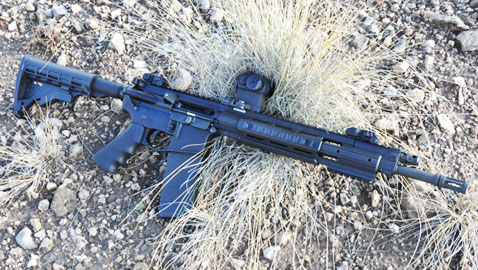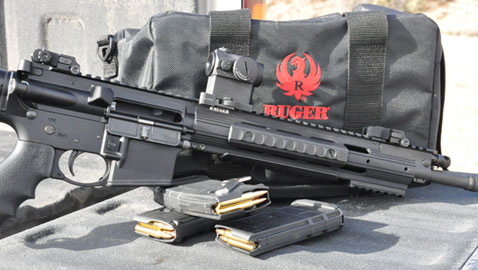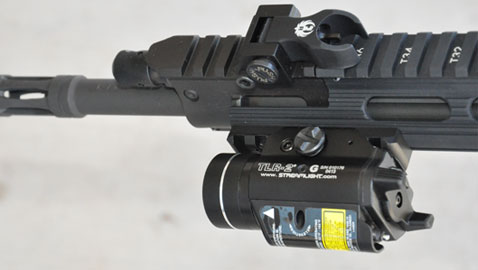Widgetized Section
Go to Admin » Appearance » Widgets » and move Gabfire Widget: Social into that MastheadOverlay zone
Reviewing the Ruger SR-556 CLA

Weighing just over 7 pounds, the Ruger SR-556 CLA is the lightest rifle in their SR line.
Everyone remembers the first time. Mine happened when I was a high school junior and it started an affair that hasn’t ended to this day. The object of my passion was sleek, black and I had never seen anything like it. They called it a Colt M-16. I suppose I was fortunate to make the acquaintance while I was still in school. My father was an Air Force officer under orders to Viet Nam and the Air Force was requiring everyone going to the war zone to attend training with the M-16. I don’t know how my father managed to include me in the training but I’m grateful he was able to arrange it.
At that time the M-16 was brand new and the Air Force was the first U.S. military branch to adopt it. We were told the rifle was made of space-age materials and required little cleaning, as the metal was self-lubricating. After learning about the rifle and practicing taking it apart we participated in a live fire course followed by a qualification. The rifle was easy to shoot well and I managed to fire an Expert score. After shooting we cleaned the rifles, which consisted of removing the bolt group, swishing it around in a barrel of kerosene and blowing it dry with an air hose before replacing it in the rifle. In the years since I have often reflected upon this early training class and wondered how these misconceptions concerning maintaining and cleaning the M16 – and the subsequent problems and failures in combat – might have been avoided if the rifle had been understood a little better in the beginning.
Volumes have been written concerning different calibers for the black rifle as well as whether the original direct gas operating system or piston operation is better so I’m not going to get into that here. The subject of this discussion is the Ruger SR-556, a highly evolved and updated semi-automatic version of the M-16 I fired those many years ago. It’s chambered in 5.56 NATO and has a modern gas piston operating system that Ruger says makes it more reliable. In my experience that is correct, as I have been shooting a SR-556 for a couple of years now and it has never malfunctioned or failed to fire.

Lately, I have been shooting a model of the SR-556 called the CLA. Weighing just over 7 pounds, it is the lightest rifle in the SR line. Ruger trimmed the weight by fluting the barrel (grooves cut in the outside of a barrel that reduce weight and promote cooling) and by installing an aluminum handguard they call a lightweight adaptive handguard. Bucking the trend towards handguards with rails on all sides, the adaptive handguard has a Picatinny rail on top while the sides and bottom are smooth. It’s a different approach to attaching accessories to the rifle that gives you the option of having a smooth forend or one with rails or handguards attached. Ruger includes two sections of Picatinny rail, three handguard pieces and the screws needed to attach them in the positions of your choice. Back to the fluted barrel, it’s cold hammer forged and chrome lined. Those features combine to give you a barrel that’s accurate, easy to clean and long lasting. The barrel on the CLA is the same length as the one on the SR-556 at 16.12 inches but the rifle looks shorter and the handling is a little livelier. This is due to a bit of an illusion. The barrel looks like it has the usual removable flash hider but it doesn’t. Flash hiders can add an inch and a half or more to the overall length of a barrel but in the case of the CLA Ruger machined the flash suppressor as an integral part of the barrel so it’s not removable and the barrel isn’t threaded. You get a shorter barrel overall but give up the ability to change the flash hider to a muzzle break or suppressor mount with the CLA.
Like the other SR rifles, the CLA is a piston gun with a chromed two-stage piston and chrome plated bolt and bolt carrier. The rifle breaks down for cleaning exactly like any other AR pattern rifle with the exception of the gas port and piston. These are easily removed by following the directions in the instruction manual. The gas port has four settings allowing the shooter to tune the rifle for a particular load. The SR-556 rifles I’ve fired have worked fine on the factory default setting of 2 but you might have to change the setting if using light loads or if the rifle is really dirty and won’t run. Keep in mind there is no point in over-gassing the rifle. The folks at Ruger tell me you can judge this by looking at the ejection pattern; if brass is coming out to the side or a bit to the rear the gas setting is where you want it. If brass is ejecting in a forward direction the rifle might be over-gassed.

RugerSR556CLA with a Streamlight TLR-2 G combat light
The trigger parts, buffer tube and six position M4 style butt-stock are standardized AR parts so you can swap parts to set the rifle up to your preferences. The mil-spec trigger of my sample breaks at 8.5 pounds with the usual creep and take-up you would expect. I often complain about these triggers and suggest replacing them but in the case of the CLA I think it’s fine because, to my mind, the little carbine is a defensive rifle and for fast work at close to moderate ranges the trigger works well. Although the rifle comes with an excellent set of adjustable, fold down, removable iron sights I mounted an Aimpoint Micro red dot sight in a LaRue mount on the top rail. To complete setting the CLA up as a home defense carbine I screwed on one of the rail pieces and attached a Streamlight TLR-2 G combat light. This is a trick setup as the light includes a green laser. You can sight the carbine in at, say 100 yards with the Aimpoint, and zero the laser for indoor use – something like 20 or 25 feet. Why would you do this? Because the Aimpoint sits about 2.5 inches above the barrel and at indoors ranges the bullet is going to strike 2 to 3 inches low. If you don’t want to have to aim high to allow for this offset during a life and death situation a distinct aiming point for close range might be a good idea.
At the range I fired the CLA on steel plates at 50, 100 and 200 yards with Black Hills 55 grain full metal jacket ammunition and with Federal 55 grain soft point Most of my shooting was rapid fire from standing and I went through a couple of hundred rounds pretty quickly. The supplied 30 round Magpul magazines worked great and the CLA ran without hesitation.
This is a very sweet little carbine. My description doesn’t do it justice – go to your dealer to see and handle one and I bet you’ll have the same impression the staff at Gunsite had when a shipment of these rifles came into the Pro Shop – they bought them up on the spot.
For more information:
www.ruger.com
www.shopruger.com
www.aimpoint.com
www.laruetactical.com
www.streamlight.com
About the Author:
 Ed Head is a regular on Shooting Gallery, Gun Stories and Down Range TV. He has worked for almost 30 years in law enforcement, first in the United States Air Force and then with the United States Border Patrol, retiring as a Field Operations Supervisor. During his Border Patrol career, Ed worked in a variety of patrol, investigative and training capacities. Ed has an extensive background as a firearms instructor, having trained thousands, ranging from beginners to police, military and special operations personnel. Having taught at Gunsite for 20 years, Ed first trained there under the world famous shooting school’s founder, Jeff Cooper, then later ran the school as the operations manager for more than five years. Ed lives in Chino Valley, Arizona, where he continues to teach and write.
Ed Head is a regular on Shooting Gallery, Gun Stories and Down Range TV. He has worked for almost 30 years in law enforcement, first in the United States Air Force and then with the United States Border Patrol, retiring as a Field Operations Supervisor. During his Border Patrol career, Ed worked in a variety of patrol, investigative and training capacities. Ed has an extensive background as a firearms instructor, having trained thousands, ranging from beginners to police, military and special operations personnel. Having taught at Gunsite for 20 years, Ed first trained there under the world famous shooting school’s founder, Jeff Cooper, then later ran the school as the operations manager for more than five years. Ed lives in Chino Valley, Arizona, where he continues to teach and write.



 MidwayUSA
MidwayUSA Ruger Firearms
Ruger Firearms SCCY Firearms
SCCY Firearms Streamlight
Streamlight Action Targets
Action Targets Gunsite Academy
Gunsite Academy
You must be logged in to post a comment Login